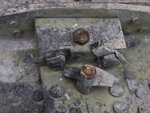I'm looking for information about this propeller blade. Unfortunatly it's boss connection is broken off an no numbers at all were found on it. The material seems to be aluminium. Color: black and on it's tip: yellow. There is one noticeable flat area near the boss area (last picture).
For it's shape and dimensions please look at the pictures attached.
width: ~31cm/12,2in
length: ~180cm/70,8in
It would be great if someone can tell me anything about it. Maybe it is possible to identify the aircraft the propeller is coming from? Thank you for any help in advance! Cheers, Kurtl
For it's shape and dimensions please look at the pictures attached.
width: ~31cm/12,2in
length: ~180cm/70,8in
It would be great if someone can tell me anything about it. Maybe it is possible to identify the aircraft the propeller is coming from? Thank you for any help in advance! Cheers, Kurtl








